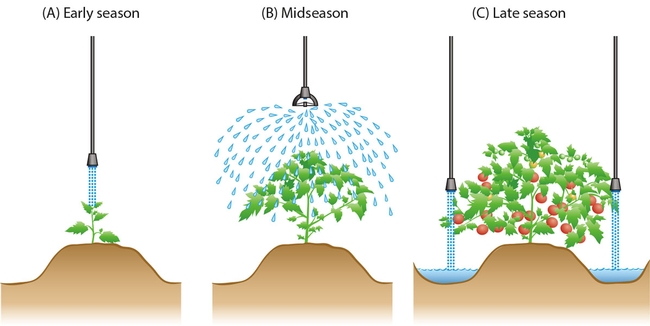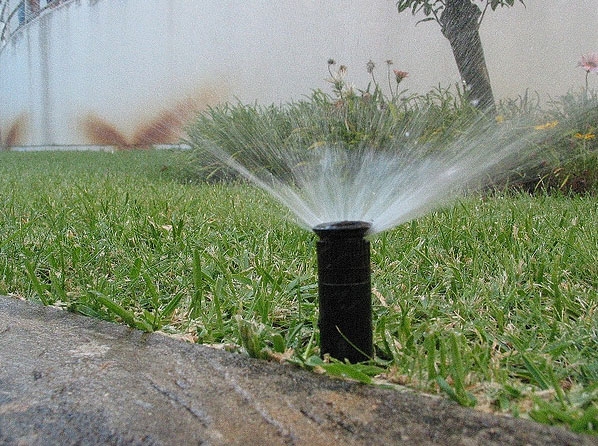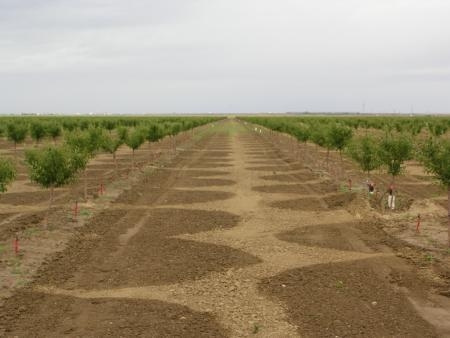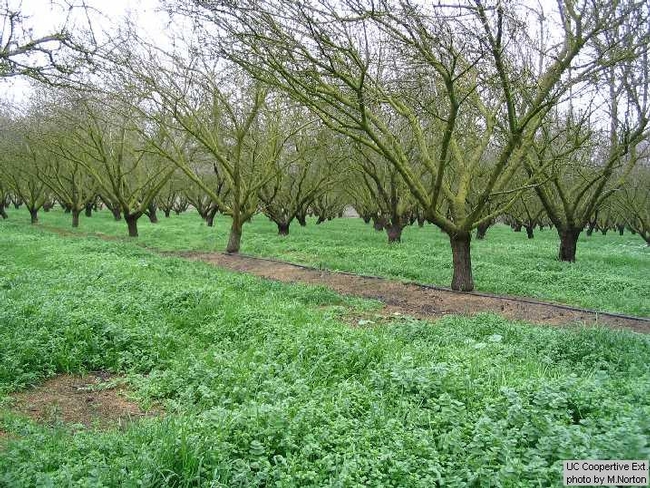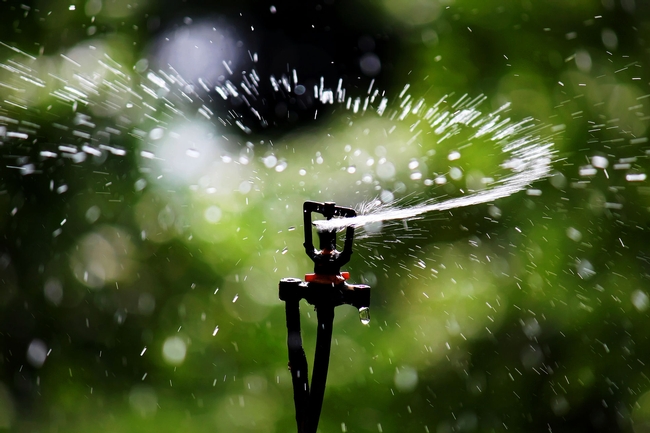Posts Tagged: irrigation
Overhead irrigation holds water-saving potential for California farms
In California, 40 percent of agriculture is still irrigated by pouring water onto farmland, a much less efficient practice that drip and overhead irrigation. But those numbers are changing, reported Matt Weiser on Water Deeply.
Weiser interviewed UC Cooperative Extension cropping systems specialist Jeff Mitchell about the water-saving potential of using overhead irrigation, a system that is popular in other parts of the nation and world, but only used on 2 percent of California farmland. Mitchell was the primary author of a research article in the current issue of California Agriculture journal, which said that water and money can be saved using overhead irrigation in production of wheat, corn, cotton, onion and broccoli.
Mitchell said California researchers are looking more closely at overhead irrigation because they anticipate future constraints on agriculture, including water and labor shortages. Additionally, the system is ideal for combining with conservation agriculture systems, which include the use of cover crops, leaving crop residue on the soil surface and reducing tillage disturbance of the soil. The combination of overhead irrigation and conservation agriculture practices reduces water use, cuts back on dust emissions, increases yield and improves the soil.
Weisner asked how overhead irrigation could be as efficient as drip, when people typically see "water spraying everywhere from these roving sprinklers high off the ground."
Mitchell said farmers use pressure regulators and a variety of nozzles on hoses hanging down from the system to deliver water at precisely the rate and location where it is needed through the season.
"So, they're not spraying water. These are low to the ground, and there are various delivery nozzle practices that can be used," Mitchell said.
Second video in series helps Californians conserve more water
Californians cut water use in July by 31.3 percent compared to the same month in 2013, exceeding Gov. Brown's 25 percent mandate for the second consecutive month, the California State Water Control Board reported last week.
With dry conditions forecast to continue through November, UC Agriculture and Natural Resources developed a series of videos with tips for enhancing conservation efforts in outdoor landscapes. The second video in the series, which debuts today, advises homeowners to limit outdoor irrigation to the early morning hours.
In the morning, says host Missy Gable, director of the UC Master Gardener Program, “you're not competing with sun or wind, both of which can cause water to evaporate from the soil.”
An obstacle to changing irrigation times for some Californians is a lack of familiarity with their own irrigation systems. The California Garden Web is an informative service of the UC Master Gardener Program that can help users understand the basics of irrigation controllers and irrigation system adjustment.
The website provides a link where residents can find their irrigation controller manuals online. A landscape irrigation worksheet developed by UC ANR researchers can be downloaded to finesse irrigation intervals and timing.
Much more gardening information can be found on the California Garden Web, which serves as a portal to organize and share UC ANR's vast collection of research-based information about gardening.
Following is the second video in the new series on water conservation in landscapes:
View the first video in the series, with advise on prioritizing plants when irrigation water is short.
An initiative to improve California water quality, quantity and security is part of the UC Division of Agriculture and Natural Resources Strategic Vision 2025.
Author: Jeannette Warnert
Farmers thirsty for water-saving technology
The California drought has farmers looking for technical innovations that will help them save water, reported Ilan Brat in the Wall Street Journal.
The article said, in the past, the state's farmers have focused on lowering their costs for labor, energy and other inputs. But now water efficiency has their attention. New technologies described in the article include:
- a nontoxic gel that, mixed in soil, stores and slowly releases water near the roots
- a machine that electrically charges mists of pesticides and nutrients to make them stick to leaves more evenly
- satellite and aerial imagery that improves irrigation planning
- a water pump monitor that identifies leaks in irrigation equipment
- applying mulch made form yard waste and construction debris to stem soil-moisture loss
Daniel Sumner, director of the UC Agriculture and Natural Resources Agricultural Issues Center, said that people focused simply on water use are looking at the issue in the wrong way. Growers who find new ways to produce more food per unit of water may generate bigger gains in water efficiency, he said.
“If we can grow more food with our water, that's presumably what we would like to do,” he said.
Flood irrigation may help recharge aquifers
UC Agriculture and Natural Resources experts are studying the effectiveness of flood irrigation to help recharge underground aquifers that have been depleted due to the drought, reported Ken Carlson in the Modesto Bee.
The pilot research project will involve flood irrigating almond orchards during the winter months, according to Roger Duncan, UC ANR Cooperative Extension advisor in Stanislaus County.
"If it works well, we can expand and potentially look at other locations, other soil types and other cropping systems," Duncan said.
The Modesto trial will take place on one orchard with 10 to 15 acres of fairly sandy soil with groundwater from another area.
According to the article, commercial almond orchards are not usually irrigated in winter because there's enough rainfall to keep the ground moist. Flood irrigation in almonds has of late been regarded as a wasteful practice from the era of cheap and plentiful water; many farmers have turned to micro sprinklers and drip irrigation for water conservation. But orchard flooding could bounce back as a strategic tool as local jurisdictions try to manage their groundwater levels.
Water wisdom coming this weekend
Two trained and certified UC Master Gardeners with UC Agriculture and Natural Resources will talk to homeowners about their irrigation systems at a free seminar May 9 called “Planning for Drought," reported Thaddeus Miller of the Merced Sun-Star.
UC Master Gardener Dave Hackney, based in the Merced County UC Cooperative Extension office, said about half of all water used in residential homes goes to the landscape. The seminar will cover products on the market that water the lawn more slowly, which allows for liquid to penetrate the ground without running off sloped lawns.
The seminar also will cover drip irrigation for home gardens. “At this point in the season, we're really concentrating on low-water plants and water efficiency for homeowners,” he said.
In Riverside, UC ANR Cooperative Extension environmental horticulturalist Dennis Pittenger will appear at a local bookstore to discuss the newly published second edition of the California Master Gardener Handbook, reported Stephanie Schulte in the Press-Enterprise.
Pittenger has been traveling around the state promoting the publication and giving tips on being water-wise, the article said. Pittenger said a recurring question keeps cropping up at his bookstore talks.
“People have a hard time knowing if they are under or over watering,” he said.
His advice is simple: “Trim back, many plants don't need as much water as you might think,” he said.


